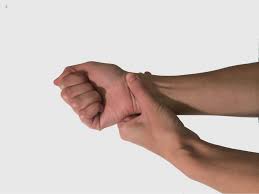Do Your Hands Feel Stiff?
A common ailment I saw this past week is stiff hands. Older clients talk about their hands feeling stiff and their grip feeling weak. Younger people will complain about a weak grip and pain at the wrist and fingers. Either way, the muscles in the hand make it difficult to open and close your hands, grip a cup or anything, and even point your fingers. Most of you ask if my hands hurt or get tired by the end of my day and the answer is, NO. I will share with you what I do and would encourage you to do the same, even if you are not in pain currently.
What Happening to Your Hands?
Each day, hundreds of times a day, we use our hands to hold things, type on a keyboard, grip a steering wheel, or grip a tennis racquet or golf club. It is no wonder that our hands hurt from time to time, yet we pay so little attention to why. As some of you have heard me say, the muscles in your forearm control the big movements of the hand, however there are 30 muscles in each hand. You can read an article about the hands HERE.
The most common area that most of you feel pain is at the base of the thumb. The reason is, we use our thumbs to hold everything and that separates us from other animals in the animal kingdom. If you look down at your hand between the thumb and index finger, you will see a triangle shaped area and it is a muscle named Thenar Eminence. We can easily see the knuckle at the base of the thumb but there is a second knuckle down next to the wrist named Saddle Joint. It is the only place on the human body that has a Saddle Joint.
This is where most people tell me they have arthritis. Some are self-diagnosing, while others have a doctor’s diagnosis. Either way, one of the first things I see is how close the thumb is to the index finger at rest. The goal is to stretch the webbing between the thumb and index finger which will lubricate the Saddle Joint and either slow down the pain or even stop it.
What Can You Do?
- Soften. If the pain is bad, begin by wrapping your hand with a heating pad to get the blood flowing into the muscle fibers. Stay there long enough to get your hand warm. Next, use the index finger and thumb of the opposite hand to squeeze the muscle between the thumb and index finger on the painful hand. AS you squeeze, breathe out and allow the muscle to relax. Remember, do not press so hard that you cannot breathe. Hold the squeeze for about 5-10 seconds then release. I would suggest doing this several times until if feels softer.
- Stretch. As you look down at your painful hand, open the thumb as wide as you can, then use the opposite hand to stretch the webbing between the thumb and index finger. You can do this by placing the thumb of one hand at the base of the thumb of the painful hand. Let me be clearer. If my right hand hurts, I will press the thumb of my left hand against the base of the thumb on my right hand. At the same time, I will wrap the other four fingers of my left hand around the thumb of my right hand. Sorry if it seems a little confusing. Now gently pull back with the left hand in order to extend the webbing of the right hand as far as possible without a lot of pain. Be sure to breathe out and allow the brain to relax the muscle of the right hand. I will put the video for this below so be sure to watch it.
- The second stretch I would do is to stretch the thumb over the whole hand. Let’s go back to the right hand and hold the hand out with the thumb pointing toward the ceiling. Next place the left hand over the right hand with the right thumb sliding between the index finger and thumb of the left hand. This will allow you to use the left hand as a wedge to press against the right thumb. Gently lift the left hand to stretch the right thumb over the right hand. Again, do not overdo it to create too much pain. I will add the video below for this one as well.
- Lastly, it is good to hold each individual finger and lift it up so the finger can move to 90⁰ to the right hand, or as far as you can. You can also push each finger down too. By doing this you can re-lubricate the knuckles of the fingers and thumb.
Conclusion
If you do this several times a day, every day, you can reduce and even stop the pain in your hand. That pain comes from overworking the hands, not moving the hands enough, or repetitive actions of the hands. Do not forget to massage and stretch the forearms too, and I have already sent you videos for these stretches. If you do not have them, contact me I will send them to you. Having hands that work freely and pain-free can change your life and you have that ability to make that change.
What is Going on with My Book?
We are completing our second re-write and preparing the manuscript to show to an agent soon. We are doing a line-by line editing to make sure the manuscript is free from grammar mistakes, writing errors, and the book information flows easily for the reader. If the agent accepts the manuscript, he will work to connect us with a national publisher.


